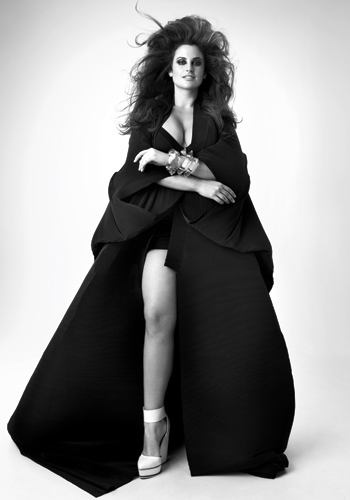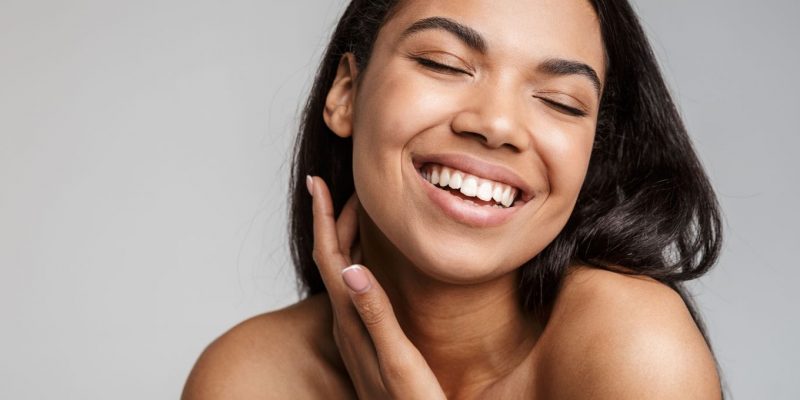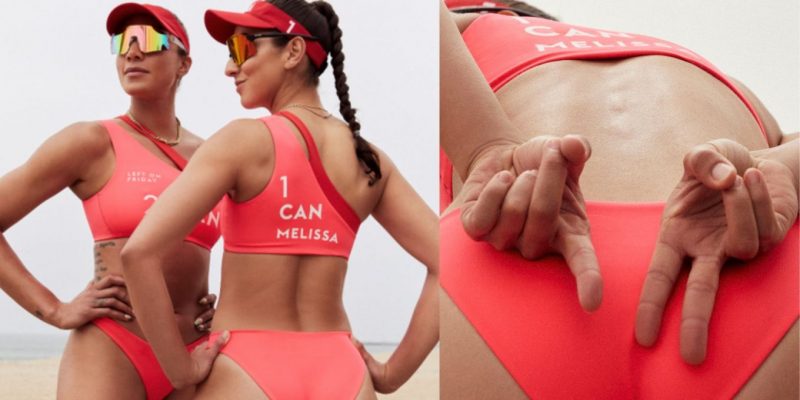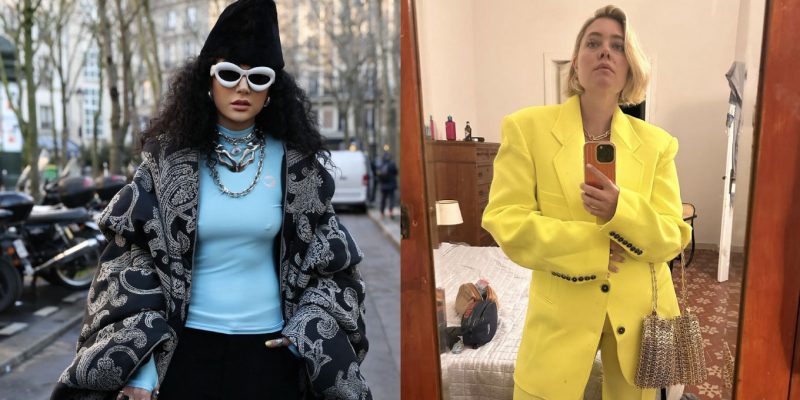Trends
What’s it really like to be a plus-size model?
We chat with top model Emily Nolan about the reality of plus-size modelling, the body image issues that arise, and where the plus-size fashion industry is headed.
by : Ava Baccari- Aug 21st, 2013

Size always matters for models. Body image struggles—weight loss and gain—are just as relevant in the lives of plus-size models as they are in the day-to-day realities of their size-two counterparts.
“You’re always struggling with ‘Oh my God, I’m getting a wrinkle,’ or ‘My waist isn’t small enough’ and you want your hips to be bigger,” says Emily Nolan, a New York-based model and blogger. “It’s really a funny industry. In modelling, especially plus
–size modelling, a size 14 [model] works the most. So a lot of women aspire to be that size.”
A matter of size
First, how do you define plus size? In most cases, a “straight” size is considered clothing that’s available in regular (that’s non-specialty) retailers, and ranges from two to 12 or 14. A plus size generally starts at 16 or 18, and reaches to about 26 or 28. But even within these numerical confines, size confusion still exists, particularly in the hiring practices of models for
designer runway shows.
How to buy CANADIAN FASHION this fall
“It’s important to show a size-8 model or a size-10 model and not to confuse that with being plus size,” says Ben Barry, a model agent and an assistant professor at Ryerson University’s School of Fashion. “But I think consumers are savvy to know that that’s not a plus-size woman.”
Barry, whose
research on the impact of diversity in modelling has shown that consumers tend to purchase from brands whose
models reflect their own size and ethnicity, notes the influence of bloggers and plus-size consumers in recent years has pressured retailers to hire authentically plus-size models for their ads. And it doesn’t stop there. “We’re seeing this huge increase in the representation of plus-size models in magazines, on runways, and we’re seeing more retailers really step up their fashion game when it comes to plus sizes. It’s exciting.”
How hard is it to be a CANADIAN FASHION DESIGNER?
Read on to find out what needs to change about the term plus-size model…
 Plus-size model—what’s in a name?
Plus-size model—what’s in a name?
For models, it’s not just a question of numbers, but one of identity. “When I lived in Florida, I always identified myself as a plus-size model,” says Nolan. “I think I’m more comfortable in New York saying I’m a model and now as I travel the world, people ask me what I do and I tell them I’m a model and I let their imagination run with it. It’s really not a big deal to me.”
The plus-size qualifier, after all, is a loaded term. The phrase can, as Barry points out, serve to “couch the term as something special, different, unique or a one-time thing. I think that’s also where the industry has sometimes taken a wrong turn because [the idea of being a plus-size model] is projected as a novelty.”
It can also tempt fashion designers and magazines to veer on the dangerous edge of tokenism by having one plus-size model on a runway or a cover and proclaiming victory. “I think plus-size women are also very savvy and skeptical of that,” Barry says. “Just as they want to see authentic plus-size models, they want an authentic incorporation of diversity, whether that’s into many issues of a magazine or multiple women in a runway show.”
FASHION DESIGNERS: Ones to watch in 2013
Plus-size fashion for the sake of fashion
Putting aside the ideological implications, plus-size fashion is, at its core, about the clothes. “Even though it represents probably half of consumers, [plus-size fashion] has really been the least innovative in terms of producing great style, inspirational images, and really fueling innovation and creativity,” says Barry, noting that retailers often tend to relegate plus-size clothes to the basement.
“There are definitely some amazing contemporary high-fashion designers who do design plus-size clothing and some brands are starting to extend into plus-size,” Barry acknowledges. “I think it means that hopefully more brands will start to offer plus sizes. But there’s definitely still an underrepresentation among fashion brands of plus-size lines available.” Canadian retailers like Addition-Elle, Toni Plus, Penningtons, and Toronto label Allistyle, who staged the first plus-size runway show at World MasterCard Fashion Week last fall, are paving the road for fashionable innovation.
The top 10 CANADIAN FASHION DESIGNERS
Where is the plus-size fashion industry headed? Read on to find out!
 Starting this fall, Ryerson’s fashion design program will implement a focus on designing for plus size and petites, in addition to straight-size women. “The goal is that we really want students to have the opportunity to express their creativity and their artistry on all sizes,” says Barry. “Size is actually irrelevant—you can translate a vision on any size and we really want to give them that inspiration and those tools and techniques to do that from day one.”
Starting this fall, Ryerson’s fashion design program will implement a focus on designing for plus size and petites, in addition to straight-size women. “The goal is that we really want students to have the opportunity to express their creativity and their artistry on all sizes,” says Barry. “Size is actually irrelevant—you can translate a vision on any size and we really want to give them that inspiration and those tools and techniques to do that from day one.”
The future of plus-size modelling
Even though just five years ago you would seldom see plus-size women on a runway or in a high-fashion magazine, “We’re not even at the tipping point yet,” says Barry. “This is just the start.”
The fact that the sample size for designer clothing is still a size two, with on-trend plus-size options difficult to access anyhow, still inhibits fashion magazines from seamlessly incorporating models into editorial spreads—unless models appear naked, in lingerie or wrapped in a sheet.
But there’s hope, and, according to Barry, it’s rooted in the blog world. Through the prominence of street style and fashion blogs, plus-size fashion has excelled both aesthetically and as an entrepreneurial venture. “The industry’s been forced to stay as innovative and creative as straight-sizing, and so this means that there are far more opportunities for plus-size models than there have been in the past.”
Commercially and career-wise, this is a good thing for Nolan and her peers. But the underlying weight and body image issues remain a personal struggle for the women themselves. “To accept who you are is a healthy feeling and that’s part of the reason that I stand up as a model, to show other women that they can do it too,” says Nolan. “It’s not just about looking pretty in pictures.”
Our editor-in-chief Noreen Flanagan and ELLE Quebec’s Sandra Abi-Rashed are among the esteemed judges at the first-ever Addition Elle model search! For more info, visit Addition Elle’s Facebook page.
Read more:
How hard is it to be a Canadian fashion designer?
Can using different types of models benefit brands?
Canadian models on the most beautiful…
How to buy Canadian fashion this fall
Newsletter
Join our mailing list for the latest and biggest in fashion trends, beauty, culture and celebrity.
Read Next

Beauty
ELLE Tried It: Five Serums to Up Your Skincare Game
Members of the ELLE team tested Avène Dermatological Laboratories’ five new concentrated serums. Here's what they thought.
by : ELLE Canada- Apr 25th, 2024

Fashion
This Canadian Swimwear Brand Designed Canada’s 2024 Women’s Olympic Beach Volleyball Team Uniforms
And they're *so* good.
by : Allie Turner- Apr 24th, 2024

Beauty
Tested and Approved: Your New Hydrating Skincare BFF
This new product has all of your skin’s thirst-quenching needs covered.
by : ELLE Canada- Apr 17th, 2024




